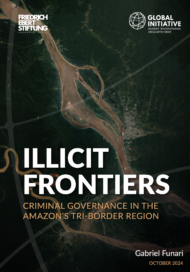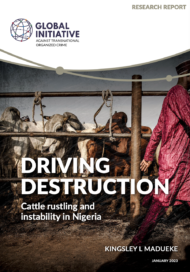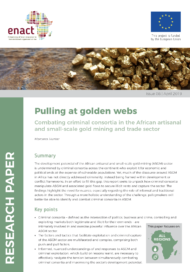Posted on 07 Jan 2019
Fishing vessels are increasingly being used as instruments in transnational organized-crime activities.
As is the case with legal global trade, a significant amount of illicit trade relies on modes of maritime transport. Vessels – ranging from small wooden dhows to major container ships – participate either willingly or unwittingly in the worldwide transfer of anything from weapons and drugs to humans, wildlife and counterfeit goods. But of specific concern is the increasing role played by fishing vessels in the global illicit infrastructure.
There are about 4.6 million fishing vessels worldwide, operated by an estimated 27 million mariners, who have expert knowledge of coastal regions and the high seas. As fish stocks become depleted, out-of-work fishermen are looking to the shadowy world of transnational organized crime to secure a livelihood. The elasticity between the legal and illicit maritime economies, particularly evident in developing and emerging economies, is of serious concern for national, regional and global stability.
In Central America, for example, Costa Rica has become an important waypoint for South American drug smugglers travelling to the US. As fish stocks off the country’s coast have fallen considerably, fishermen have become integrated into smuggling networks, some even selling government-subsidized fuel to maritime drug traffickers. This cheaper fuel means criminals are more able to complete their entire journey at sea, making it more difficult for law-enforcement organizations to intercept the illicit goods and those who traffic them.
Fishermen are also being tasked with smuggling drugs themselves. The Costa Rican Coast Guard has reported that cocaine is often smuggled on fishing trawlers, hidden beneath their cargoes of fish and ice. Towing watertight cocaine bundles below the surface is another tactic that fishermen-turned-drug smugglers deploy.
The issue of fishing vessels being used for drug smuggling poses a challenge up and down the coasts of Central and South America. In recent years there has been a surge in volumes of cocaine shipped from Colombia, Bolivia and Peru to the US along sea routes in the Pacific and the Caribbean. Along these routes, the drugs are relayed between the territorial waters of Ecuador, Panama, Costa Rica, Guatemala, Honduras and El Salvador. Over a four-day period in 2017, for example, authorities seized 3.2 tonnes of cocaine off the coast of Ecuador.
From a financial perspective, fishermen have good reason for making the transition to crime: a typical fisherman in Central America makes about US$300 a month; drug traffickers, meanwhile, can offer as much as US$25 000to fishermen to help ship drugs along the coast.
And drugs are not the only commodities that are being trafficked on fishing vessels. Venezuelan fishermen are using their vessels to smuggle guns to Trinidad, and diapers and baby formula back to Venezuela.
Fishing vessels used as facilitators of maritime crime have become a global phenomenon. In the Arabian Sea, for example, dhows have become part of the region’s arms-smuggling network. Through the multinational Combined Task Force (CT150) patrolling the area, the US navy regularly interdicts vessels carrying thousands of weapons on board. In one seizure alone, the navy confiscated 1 500 AK-47 assault rifles, 200 rocket-propelled-grenade launchers (RPGs) and 21 machine guns that were being smuggled from Iran to Tehran-supported Houthi rebels in Yemen. In another instance, the Australian navy discovered more than 2 000 weapons hidden under nets on a small fishing boat bound for Somalia. The weapons confiscated from the Iranian crew included assault rifles, RPGs and mortars.
Fishing boats are deployed not only for smuggling – they are also used in conflict. In June 2018, there was an effort by Shia rebels to arm several fishing vessels with RPGs and carry out attacks in the Red Sea shipping channel, which would have disrupted trade in this critically important waterway. Although these plans never came to fruition, there are instances where fishing vessels did play a critical role in unconventional warfare. For example, the devastating 2008 terror attacks in Mumbai, India, were possible in part because the terrorists arrived in a fishing vessel, which helped them avoid suspicion. The gunmen had hijacked an Indian fishing boat in Pakistan and anchored it near the coast, using dinghies to reach shore and carry out the attacks, which left 174 people dead and over 300 injured. The navy became suspicious of the vessel only after the attacks had begun.
There is also growing awareness of the use of slave labour on fishing vessels, but it is less known that vessels are also used to smuggle people into and out of countries. In Thailand, fishermen are converting the holds of their boats to allow them to smuggle humans. Thai fishing vessels are used to smuggle Rohingya Muslims fleeing persecution in Myanmar into Thailand, from where they are transported to countries such as Malaysia, where they are more likely to find work. The operators of these boats earn between US$150 and US$300 for each smuggled person, and some vessels can carry as many as a thousand people.
The deployment of fishing vessels in human trafficking is not limited to South East Asia, however. British fishermen are frequently offered 25 times their daily wage to smuggle people into the UK. And while Florida remains the main destination for maritime smugglers in the US, small fishing boats are increasingly ferrying people to California from Mexico, in what is touted as a much safer journey than the land border crossing. Given the beefed-up US border security on land, combined with increased access to fishing vessels, maritime irregular immigration may be one of the next big challenges facing the US.
Fishing has become an unreliable source of income, a consequence of rampant overfishing, with the result that an increasing number of fishermen are jumping ship to transnational organized crime, where their vessels and expertise are valued commodities. This is a serious problem that requires a committed response. At a high level, such a response should include a more sustainable management of fishery resources, the provision of alternative job opportunities to struggling fishermen, and stepped-up surveillance and enforcement efforts to combat criminality at sea.
Photo credit: Graeme MacFadyen, Poseiden



